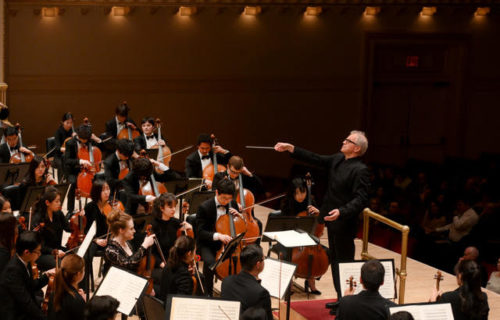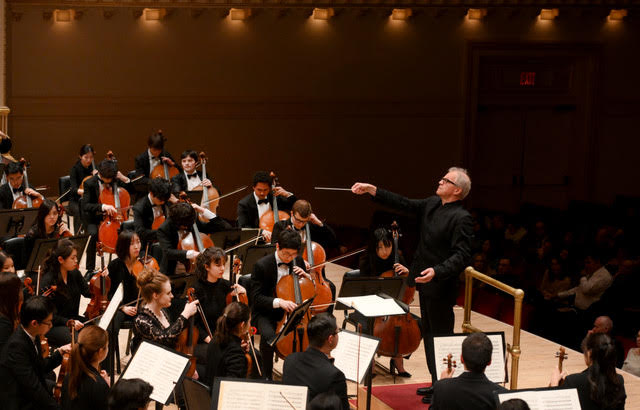 United States Smith, Beethoven, Sibelius: Jonathan Biss (piano), Curtis Symphony Orchestra / Osmo Vänskä (conductor). Carnegie Hall, New York, 8.2.2020. (RP)
United States Smith, Beethoven, Sibelius: Jonathan Biss (piano), Curtis Symphony Orchestra / Osmo Vänskä (conductor). Carnegie Hall, New York, 8.2.2020. (RP)

Smith – f(x) = sin²x –1/x
Beethoven – Piano Concerto No.5 in E-flat major Op.73 ‘Emperor’
Sibelius – Symphony No.2 in D major Op.43
The Curtis Symphony Orchestra concluded its first-ever US tour by playing Carnegie Hall. That hasn’t happened since 2016, and there was electricity in the air as yet another generation of Curtis students walked on to the stage. In due time these 100 extravagantly talented young people will be making their presence felt as soloists and chamber musicians, as well as playing in the world’s major orchestras and leading opera houses. It’s an orchestra of virtuosos who combined to play magnificently as one.
They performed under the baton of Osmo Vänskä, who will step down as music director of the Minnesota Orchestra at the end of 2022; in January, he became music director of the Seoul Philharmonic Orchestra. For this concert, the two major compositions were Beethoven’s Emperor Concerto and Sibelius’s Second Symphony. Having recorded critically acclaimed recordings of Sibelius’s complete orchestral works and the nine Beethoven symphonies with the Lahti Symphony Orchestra, Vänskä knows his way around this music.
The most striking aspect of Vänskä’s interpretations of both was his emphasis on drawing lyricism and buoyancy from the young players. His penchant for crisp articulation and transparency was ever present, but the focus was always on line and continuity. Vänskä’s sense of humor also bubbled up from time to time; he appeared to be having a lot of fun getting the entire orchestra to play as softly as possible, to say nothing of the magic he worked with the lower strings in the Sibelius. The joy was contagious as the orchestra members likewise flashed broad smiles and darted glances at one another as they delighted in the music they were making.
The concert began with Gabriella Smith’s short piece for orchestra, f(x) = sin²x –1/x. Smith, who graduated from Curtis with a Bachelor of Music in composition, has been hailed as ‘the coolest, most exciting, most inventive new voice I’ve heard in ages’ (Musical America). She conceives music in terms of the overall arc and shape of the work, and here expressed the curves as a mathematical function. In musical terms this equates to a very soft beginning that builds to a small climax, decays, and then regroups and crescendos to an abrupt end.
The opening measures of f(x) = sin²x –1/x brought to mind the fourth movement of Beethoven’s Ninth Symphony, in terms both of the sense of expectancy created by the initial, hushed, chaotic swirl of sound and the cogency that suddenly emerged from it. There was a sense of playfulness to it too, especially when Concertmaster Cherry Choi Tung Yeung and Principal Second Violin Matthew Hakkarainen tossed long slides of sound back and forth. As he would the entire evening, tympanist Julien Bélanger impressed with his virtuosity. It was over in a flash, and I was still puzzling over the equation when the last notes sounded.
Curtis didn’t have to look far for a soloist for Beethoven’s Emperor Concerto: Jonathan Biss is not only an alumnus of the school, he also serves on its faculty. From the flourishes that open the first movement, Biss approached the piano part with integrity and elegance. The mighty chords and dazzling finger work were impressive, but the delicacy with which he played the intimate passages was even more remarkable. Throughout, Vänskä drew a majestic, supple flow from the orchestra, exemplified by the rich sound of the violins and the excellent horn section.
Certainly one of the reasons that Vänskä chose Sibelius’s Second Symphony is that it showcases the individual sections of the orchestra. At the downbeat, the entire hall instantly resonated with the wonderful, warm sound of the strings, while the long pizzicato sequences for the cellos and double basses in the second movement were played flawlessly. Woodwinds and trumpets were spot-on throughout. Rather than bringing the symphony to a triumphant conclusion, Vänskä ended it with the spirit of hope and optimism hanging in the air.
For an encore, Biss gave a wistful performance of ‘Der Dichter spricht’ from Schumann’s Kinderszenen. Vänskä led the orchestra in two encores, Sibelius’s ‘Valse triste’ and the lesser known ‘Cortège’. The melancholy waltz was given a gossamer sheen by the strings and winds, while the latter piece provided a final chance to hear the exciting brass section in music alive with the rhythms and colors of Spain.
Rick Perdian
